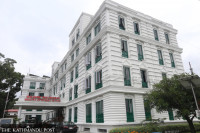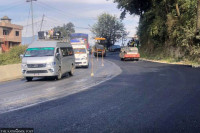National
With release of new map, Nepal and India enter a state of ‘cartographic war’, experts say
While tensions are likely to escalate in the days to come, the move will ultimately pave the way for talks with India and a shift in bilateral relations, they say.
Anil Giri
Nepal on Wednesday released its new political and administrative map, the first since the signing of the Treaty of Sugauli in 1816, including territories that have long been claimed by both Nepal and India, prompting analysts to describe it as a “cartographic war” between the two countries.
Nepal’s unveiling of the political map depicting Kalapani, Lipulekh and Limipiyhura on the norwestern corner bordering India and China follows New Delhi’s inauguration of a link road via Lipulekh, at 17,000 feet, to Kailash Mansarovar in the Tibet Autonomous Region of China.
With the inclusion of 335 square kilometres of land, Nepal’s total area is now 147,516 square kilometres, up from 147,181 square kilometres, said authorities.
Later on Wednesday, in response to questions from the media at a regular press briefing, Anurag Srivastava, spokesperson for the Indian Ministry of External Affairs, said that Nepal had acted unilaterally.
“The Government of Nepal has released a revised official map that includes parts of Indian territory. This unilateral act is not based on historical facts and evidence. It is contrary to the bilateral understanding to resolve the outstanding boundary issues through diplomatic dialogue. Such artificial enlargement of territorial claims will not be accepted by India,” said Srivastava.
Srivastava went on to say that Nepal was well aware of India's position on the matter and urged Nepal “to refrain from such unjustified cartographic assertion and respect India's sovereignty and territorial integrity”.
“We hope that the Nepalese [SIC] leadership will create a positive atmosphere for diplomatic dialogue to resolve the outstanding boundary issues,” he said.
Nepal’s new political map was unveiled six months after India released its own political map, placing Kalapani within its borders.
With both countries laying claim to the same piece of land via official maps, the boundary dispute has now entered a new phase that could be more conducive to talks, say experts.
“We are now in a cartographic war because both countries have claimed the same territory,” Toyanath Baral, former director general of the Survey Department, told the Post. “This will put pressure on both sides to break the status quo and sit for negotiations.”
India has long been reluctant to sit for talks with Nepal. By opening the road link earlier this month, New Delhi once again touched a raw nerve in Nepal. The Ministry of Foreign Affairs issued a statement, warning Delhi not to carry out any activity in Nepali territory. India’s Ministry of External Affairs responded, asserting that road construction was within Indian territory.
Kathmandu then summoned Indian Ambassador Vinay Kumar Kwatra and handed him a diplomatic note, making Nepal’s position clear on Lipulekh. The Indian embassy, however, refused to acknowledge the note, and said instead that the ambassador had handed over a copy of the External Affairs Ministry’s statement to Foreign Minister Pradeep Gyawali, much to Kathmandu’s chagrin.
In its statement, India’s External Affairs Ministry had, for the first time, acknowledged that preparations were ongoing to hold talks at the foreign secretary level and that a date could be finalised once the Covid-19 emergency was over.
“India has been occupying the land but it is reluctant to sit for talks. The situation will likely become more complicated in the days to come but with the release of the new map, there will be pressure on both sides to sit for talks and resolve the issue,” said Baral.
By introducing a new map, the first substantial step that Nepal has taken so far in pressing its territorial claims, Nepal has broken with the status quo that prevailed since the 1960s, said Kamal Thapa, a former foreign minister who has a long history of negotiating with India on various issues.
“With this incident, the entire gamut of Nepal-India relations could change. The time has come to revisit the status quo prevailing in our ties since the Sugauli Treaty,” said Thapa. “India has placed its troops in Kalapani due to strategic reasons, so negotiations will be difficult but Nepal should not let the issue go.”
According to Thapa, tensions could rise on both sides in the days to come, but ultimately, it will be for the best, as this incident has opened up more avenues for discussion.
“We could revisit the relevancy of the 1950 peace and friendship treaty and the open border, which will ultimately pave the way for more robust Nepal-India relations,” he said.
The new map released on Wednesday will come into use from Thursday, with the Ministry of Land Management writing to all government ministries and agencies to employ the new map in all official capacities, according to a senior official at the ministry.
“We expect that the Ministry of Foreign Affairs will circulate a notice to the United Nations, foreign countries and other multilateral organisations about Nepal’s adoption of the new map,” he said.
Analysts, however, say that releasing a map alone will not bring back Nepali territories that are currently occupied by India. On Tuesday, Prime Minister KP Sharma Oli had vowed before Parliament to reclaim the territories, assuring lawmakers that it was not mere rhetoric.
But before anything substantial happens, there is likely to be an escalation of tensions in the days to come, said Deep Kumar Upadhyay, a former Nepali ambassador to India.
“Nepal should avoid conflict but I see an escalation of tension and adversity with India,” said Upadhyay. “I hope releasing the map will put pressure on India but will we be able to face off with India? Are we ready to resist any kind of conflict?”




 9.68°C Kathmandu
9.68°C Kathmandu









%20(1).jpg&w=300&height=200)





